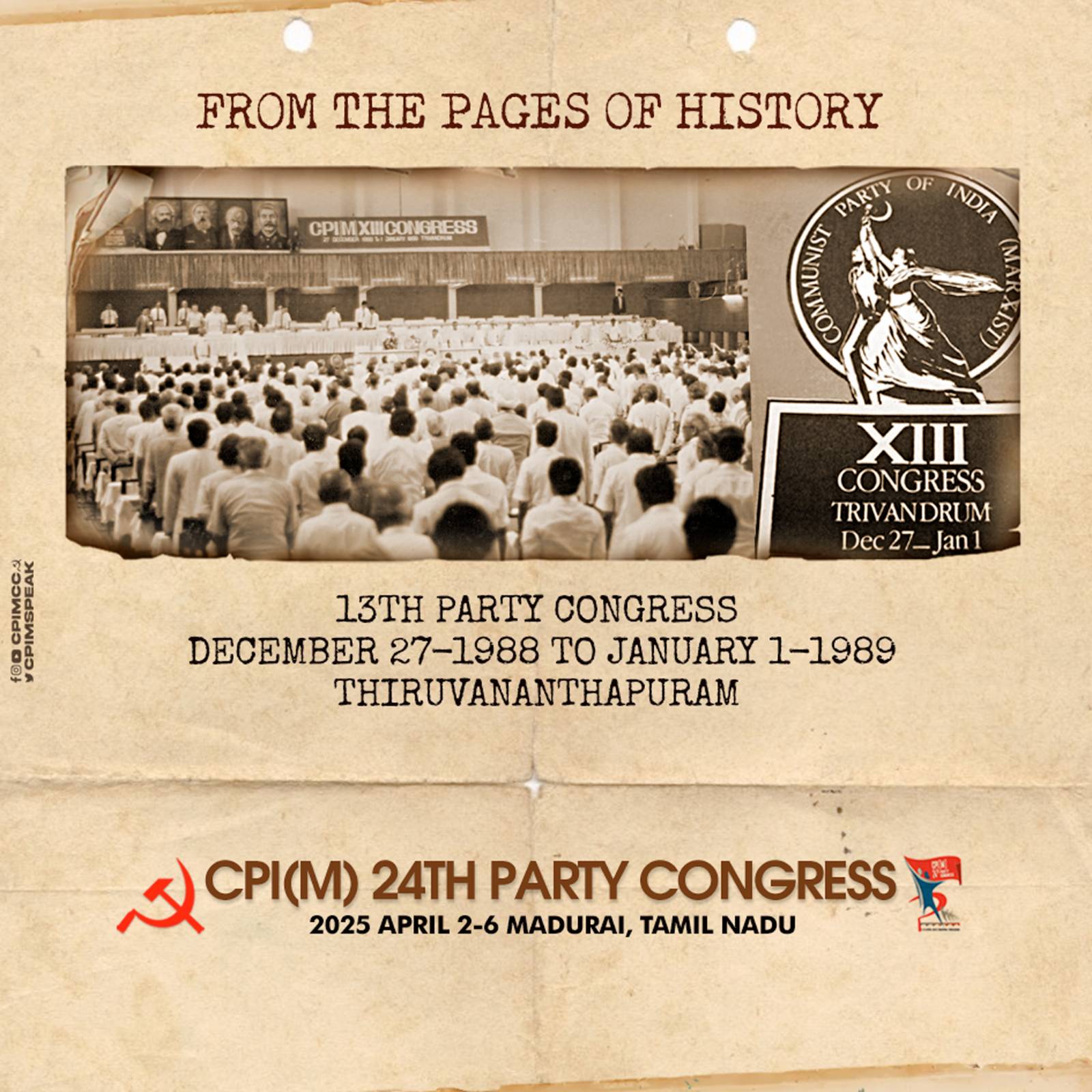The Thirteenth Party Congress of the Communist Party of India (Marxist) (CPI(M)), held from December 27, 1988, to January 1, 1989, in Thiruvananthapuram, was a significant gathering that reflected the party’s response to both global and domestic political shifts. This period was marked by transformative changes in the Soviet Union and economic policy shifts in India, prompting the CPI(M) to reaffirm its ideological commitments and political strategies.
International Context: Soviet Reforms and CPI(M) Disagreement
The late 1980s saw the Soviet Union under Mikhail Gorbachev introducing perestroika and glasnost, reforms aimed at economic restructuring and political openness. Perestroika involved market-like reforms to make socialism more efficient, while glasnost promoted transparency and freedom of expression. These changes, however, were viewed critically by the CPI(M). The party saw these reforms as a negation of Marxsim-Leninism and the leading role of the Communist Party, aligning with their traditional stance against revisionism. Historical analysis suggests that the CPI(M) refused to align with these rapid changes in the global communist movement, as evidenced by contemporary reports CPI(M) Thirteenth Party Congress significance.
Domestic Context: Opposition to Rajiv Gandhi’s Policies
Domestically, the CPI(M) was actively opposing the economic policies of Rajiv Gandhi’s government, which they perceived as surrendering to World Bank demands and making concessions to foreign capital. Rajiv Gandhi’s tenure (1984–1989) saw initial steps towards economic liberalization, including relaxing the license raj and encouraging foreign investment, which the CPI(M) criticized as pro-capitalist and detrimental to India’s economic sovereignty. Historical accounts indicate that the party was particularly vocal against policies that favored foreign interests, aligning with their broader critique of neoliberal economic reforms Rajiv Gandhi economic policies.
Moreover, the CPI(M) positioned itself as a bulwark against communal, separatist, and divisive forces. In 1988, India faced significant communal tensions, such as the escalating Babri Masjid-Ram Janmabhumi dispute, and separatist movements in Punjab and Assam. The party’s program emphasized fighting against communal hatred and separatism, promoting secularism and unity, as seen in their historical stance documented in party literature CPI(M) party programme.
Political Objectives: Protecting Left Governments and Electoral Strategy
The Thirteenth Party Congress had clear political objectives, including protecting Left governments in Kerala and West Bengal. In 1988, the Left Democratic Front (LDF), led by CPI(M), was in power in Kerala, and the Left Front, also CPI(M)-led, had been ruling West Bengal since 1977. The Congress called for safeguarding these governments against central interference and strengthening their position. Simultaneously, it aimed to oust the Rajiv Gandhi government in the 1989 general elections, reflecting the party’s strategy to expand its national influence Left governments in 1988 and Left Front (West Bengal).
The call to strengthen Left unity was another key focus, aiming to consolidate the fragmented left-wing forces to present a united front against the ruling Congress and other opposition parties. This was particularly relevant given the political fragmentation and the need for a cohesive strategy in the upcoming elections.
Leadership Elections: Central Committee and Key Positions
The Congress resulted in significant organizational changes, with a 66-member Central Committee elected to serve as the highest decision-making body between party congresses. The newly elected Central Committee then elected E.M.S. Namboodiripad as the General Secretary, a prominent figure in Indian communism known for his leadership in Kerala’s first communist government. A 12-member Polit Bureau was also elected to handle executive functions, alongside a 5-member Secretariat for day-to-day operations. These elections underscored the continuity of leadership and the party’s commitment to its ideological line CPI(M) leadership structure.
Detailed Composition and Implications
The composition of the Central Committee, with 66 members, reflected the party’s broad representation across states, particularly its strongholds in Kerala and West Bengal. The election of E.M.S. Namboodiripad, a veteran leader, as General Secretary, highlighted the party’s reliance on experienced figures during a period of ideological and political challenges. The 12-member Polit Bureau and 5-member Secretariat ensured efficient decision-making and operational management, aligning with the party’s hierarchical structure.
Historical Significance and Unexpected Details
The Thirteenth Party Congress was notable not only for its political resolutions but also for its timing, occurring amidst global communist reevaluation and domestic economic liberalization. An unexpected detail is the CPI(M)’s refusal to align with Soviet reforms, which contrasted with some other communist parties globally that embraced these changes, highlighting the party’s ideological rigidity. This stance had long-term implications for its international relations and domestic strategy, particularly in maintaining its voter base in left-leaning states.
Below is a table summarizing key details of the Thirteenth Party Congress:
| Aspect | Details |
|---|---|
| Dates | December 27, 1988 – January 1, 1989 |
| Location | Thiruvananthapuram, Kerala |
| Central Committee | 66 members elected |
| General Secretary | E.M.S. Namboodiripad |
| Polit Bureau | 12 members elected |
| Secretariat | 5 members elected |
| Key Objectives | Protect Left governments, oust Rajiv Gandhi, strengthen Left unity |
Political context:
| Context | Details |
|---|---|
| International | Soviet perestroika and glasnost, CPI(M) opposition |
| Domestic Economic | Opposition to Rajiv Gandhi’s liberalization policies |
| Domestic Social | Fight against communalism, separatism, and divisiveness |
| State Governments | Left in power in Kerala and West Bengal in 1988 |
